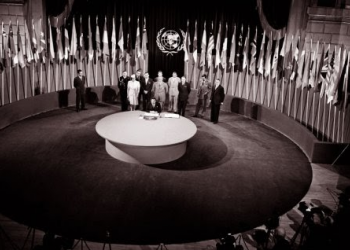75 Years Later, Time for the Vision and Commitment of Another ‘Charter Moment’
What happened in the Herbst Theatre auditorium in San Francisco 75 years ago today was not a foregone conclusion. When the United Nations Conference on International Organization convened in April of 1945, hostilities in the ongoing war had not yet concluded in any part of the world. Delegates from 50 countries clashed repeatedly over issues of membership and voting, at times throwing the fate of the entire process into question. And the challenges and ultimate inability of the League of Nations to prevent conflict were fresh in the collective memory.
That the international community was able to overcome such obstacles was a notable step forward in the global order. Shortcomings notwithstanding, the Charter articulated humanity’s most ambitious attempt yet to secure the peace and prosperity of the world’s people. And on its anniversary, when such dramatic parallels of both crisis and potential can be seen between then and now, a key question arises: What would a corresponding feat of vision, collaboration, and statesmanship look like today? What might be this generation’s “charter moment”?
The UN is not perfect, of course. Its structures and systems, for example, continue to reflect the power relations and compromises of an age now past. But perfection was never the goal; progress was. After all, the Charter itself provides for a General Conference—envisioned within the first ten years of operation but yet to be convened—to review its provisions.
Reforms of various kinds are unquestionably needed in the UN. Specific proposals—from establishing new bodies like a second chamber of the UN, to reforming existing ones such as the Security Council, to developing needed processes like a reorganized funding mechanism—are numerous. Many are worthy of thoughtful exploration.
Yet the needs of the current moment call for advances more profound than technical adjustments alone. The international order was founded on Westphalian conceptions of national sovereignty that, while not without utility, no longer reflect the full reality of the contemporary world. From global supply chains, digital interconnection, and the operation of multinational corporations, to global financial flows, the spread of infectious disease, and multiplying effects of climate change, nation states are far more interdependent—and, in practice, less classically “sovereign”—than they were in 1945.
These ties of interconnection have opened possibilities for collaboration on scales never before possible. Yet just as the delegates 75 years ago recognized and responded to the limitations of the League of Nations, today’s leaders must identify and overcome the limitations that hinder the present international order. While the UN has succeeded in averting world war, challenges of collective action such as the effects of climate change or widening extremes of wealth and poverty, demand far deeper unity of thought and action. Such challenges can only be resolved within a framework that recognizes the ways in which humanity increasingly functions as one common people in one global homeland.
Representatives of the Baha’i International Community called for recognition of this oneness at the founding of the UN, and the principle continues to be central to its understanding of progress today. “The well-being of mankind, its peace and security, are unattainable unless and until its unity is firmly established,” Baha’u’llah declared over a century ago.
The prospect of formulating policy on the basis of the oneness of humankind, rather than the logic of country-first national interest, might seem out of reach to some. Yet efforts in this direction have clear historical experience on which to draw. The smallpox virus was eradicated by a coordinated World Health Organization campaign, not by a patchwork of national responses split by borders and jurisdictions. Similarly, the technical standards maintained by the UN’s International Telecommunication Union have benefited the world far beyond what a host of conflicting claims to the radio spectrum, broadband internet, and satellite orbits ever could.
In at least a few key areas, then, there is clear recognition that unity and cooperation already serve the international community better than division and competition. Expanding the number of such areas, in which the power of the oneness of humanity has been released to advance the common good, is a project that will continue for years to come. Yet meaningful change need not be delayed. By extending the implications of cooperative approaches from one system or policy area to the next, in a spirit of learning and exploration, steps can be taken today to lay sure foundations for a more effective global order.
Seventy-five years ago leaders were able to combine a deep reassessment of global arrangements with practical, achievable steps to build a more fitting order. Let leaders and diplomats today—bolstered by civil society engagement and the support of individuals around the world—channel that same spirit of common endeavor. In this way, let them contribute their share to a process of collective advancement worthy of being recognized as this generation’s charter moment.
